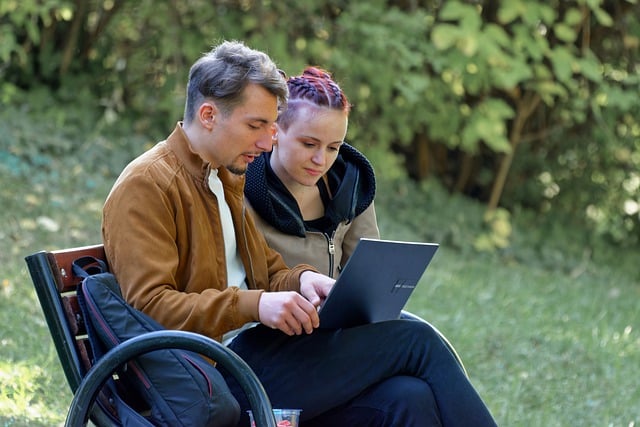Parental control apps are essential tools in today's digital era for managing and understanding children's online presence. These apps enable parents to monitor browsing history, set time limits, and track locations, providing safety from predators and inappropriate content. Features like "find my kid" foster open dialogue about digital citizenship and responsible online behavior. While these apps offer monitoring, they should complement open communication between parents and kids regarding privacy, cyberbullying, and online conduct. By combining education, parental oversight, and tools like parental control apps, parents can ensure their children's safety in the vast digital landscape.
In today’s digital era, understanding your child’s online safety is paramount. Their digital footprint, or virtual trail left through internet activity, can reveal a wealth of information about their interests, interactions, and even location. This article guides parents on navigating this landscape, focusing on the power of parental control apps to monitor children online. We’ll explore benefits like enhanced security, common challenges and busting myths, and offer essential tips for open communication, ensuring your child’s digital movements are as safe as possible.
- Understanding Digital Footprints: The Online Presence of Your Children
- The Role of Parental Control Apps in Monitoring Online Activity
- Benefits of Tracking Your Child's Digital Movements
- Common Challenges and Myths About Online Safety and Monitoring
- Tips for Open Communication: Discussing Online Safety with Your Kids
Understanding Digital Footprints: The Online Presence of Your Children

In today’s digital era, it’s imperative for parents to understand and grasp the concept of their children’s digital footprints — the trail of online activities and interactions that shape their digital identities. Every click, post, and search query contributes to this invisible yet powerful record, which can be accessed by anyone with internet access. This includes potential strangers, who may use this information to track or even harm your child.
Parental control apps offer a crucial solution for monitoring children’s online activities, allowing parents to stay one step ahead of the digital landscape. These tools enable you to “find my kid” virtually, tracking their location, browsing history, and interactions on various platforms. By using parental control apps, parents can ensure their children are safe from online predators, inappropriate content, and other digital dangers, while also fostering a healthy relationship with technology.
The Role of Parental Control Apps in Monitoring Online Activity

Parental control apps have emerged as powerful tools for parents to navigate the digital landscape and ensure their children’s safety online. These innovative solutions offer a way to monitor children’s activities, providing peace of mind and an extra layer of protection in the vast world of the internet. With just a few taps on a smartphone, parents can track their kids’ browsing history, set time limits for specific apps, and receive alerts when certain keywords or inappropriate content are encountered.
The ability to “find my kid” digitally is a significant feature, allowing parents to locate their children’s devices and ensure they are in safe environments. This technology empowers parents to be proactive about online risks, from cyberbullying to exposure to harmful content. By utilizing parental control apps, families can foster an open dialogue about digital citizenship, teaching children responsible online behavior while maintaining a watchful eye on their digital footprints.
Benefits of Tracking Your Child's Digital Movements

Tracking your child’s digital movements offers numerous benefits in today’s digitally interconnected world. Parental control apps provide parents with a powerful tool to monitor children online, ensuring their safety and well-being. By using these apps, parents can gain valuable insights into their child’s digital activities, including the websites they visit, the people they interact with, and the content they consume. This proactive approach enables parents to foster open communication about online risks and opportunities.
Moreover, parental control apps offer a sense of security by helping parents locate their child if needed, using features like GPS tracking. With just a few taps on a smartphone, parents can “find my kid” and ensure their immediate safety. This peace of mind is invaluable as children navigate the online realm, allowing parents to focus on fostering a healthy relationship with technology while keeping them protected from potential dangers.
Common Challenges and Myths About Online Safety and Monitoring

Online safety is a topic that often comes with its share of challenges and misconceptions, especially when it involves monitoring children’s digital activities. Many parents are under the impression that installing parental control apps is a magical solution to completely shield their kids from online risks. However, it’s important to recognize that these tools are not infallible and can’t replace open communication between parents and children about digital citizenship. The reality is that while parental control apps offer certain levels of monitoring, they may not always keep up with the evolving digital landscape.
Additionally, there’s a common myth that if you’re not actively searching for “find my kid” features, your child is safe from online predators or harmful content. This couldn’t be further from the truth. Children can encounter numerous dangers without parental awareness, including cyberbullying, inappropriate content, and even stranger interactions. Monitoring children’s online activities requires a proactive approach, focusing on education, open dialogue, and using tools that provide insights rather than complete control.
Tips for Open Communication: Discussing Online Safety with Your Kids

Open communication is key when discussing online safety with your kids. Create a safe and non-judgmental space for them to ask questions and share their experiences. Start early by teaching them about privacy settings, personal information, and responsible online behavior. Regularly check in on their activities by monitoring their devices and using parental control apps. This doesn’t mean invading their privacy but ensuring they’re protected from potential dangers.
When talking about their digital footprints, help them understand that every action online leaves a trace. Encourage them to think before posting and consider the long-term implications of their digital interactions. Teach them about cyberbullying, online predators, and phishing scams. Make sure they know how to recognize and report inappropriate content or behavior. Regularly discuss these topics to keep the conversation going and adapt it as they grow older and navigate new online platforms.
